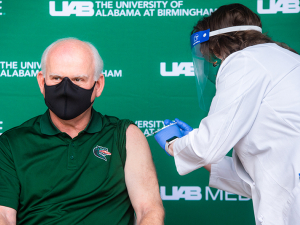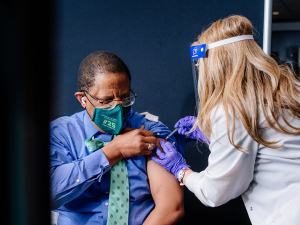





Thousands of frontline UAB Medicine physicians, nurses, environmental services staff members and more have received the Pfizer vaccine, to date. While all have their own personal reasons for wanting to be vaccinated, the joy and excitement of having this protection has been a key theme each and every day vaccinations take place.
UAB vaccine distribution: by the numbers
|
- Michael Saag, M.D., professor of medicine in UAB’s Division of Infectious Diseases
The Vaccine and How It Works
The active ingredient in the vaccines from Pfizer and Moderna, is messenger RNA, which is genetic information used to make the spike protein found on the outside of the SARS-CoV-2 virus that causes COVID-19. The spike protein is the part of the virus that attaches to human cells. The spike protein is recognized by the body’s immune system to develop protection from infection.
The spike protein alone cannot cause COVID-19. Once the spike protein is created, it causes the immune system to make antibodies against the virus. These antibodies can then provide protection if a person comes into contact with the virus. mRNA vaccines are non-infectious and do not enter the human cell nucleus, so the mRNA cannot be inserted into human DNA. mRNA vaccines do not have the ability to cause cancer.



All vaccines help develop immunity by imitating an infection. Vaccines greatly reduce the risk of infection by working with the body’s natural defenses to safely develop immunity to disease. When germs, such as viruses, invade the body, they attack and multiply. This invasion, called an infection, is what causes illness. The immune system uses several tools to fight infection. The first time the body encounters a germ or virus, it can take several days for the body to make and use all the germ-fighting tools needed to fight the infection. After the infection, the immune system remembers what it learned about how to protect the body against that disease.
While some vaccines, such as flu vaccines, use dead or deactivated virus to imitate the infection, the Pfizer and Moderna vaccines currently approved for COVID-19 do not. They use the body’s messenger RNA to teach the immune system to recognize the SARS-CoV-2 virus. A person cannot get COVID-19 from the vaccine.
“The Pfizer and Moderna vaccines work the exact same way and are equally successful, both at 95 percent efficacy. A person should not be worried if they received one vaccine while a friend received the other – the end benefit of protection from the COVID-19 virus is nearly identical and will help us move past this pandemic if everyone gets inoculated.”
- Paul Goepfert, M.D., director of UAB’s Alabama Vaccine Research Clinic
- Michael Saag, M.D., professor of medicine in UAB’s Division of Infectious Diseases
Myth: Once I have the vaccine, its safe for me to go back to life as it was.
Not exactly. While you will have significant immunity to the virus, data is not conclusive yet as to if people can still transmit the virus to those who are not vaccinated. Until there is significant inoculation across the country – and world – it will be key for everyone to keep wearing masks and social distancing to curb the spread of the virus. Once a majority of people are vaccinated, the virus will eventually tire out since there are not enough hosts to sustain it.
| Join the fight against coronavirus. Be a part of UAB’s mission to defeat COVID-19. |
Myth: Many people already have died from the COVID-19 vaccine trials.
No patients have died from receiving any of the vaccines during the trials. One patient in the AstraZeneca trial died; but this person received a placebo, not the actual vaccine.
Myth: If I have had COVID-19, I won’t have to get the vaccine because I am already immune.
Most patients develop antibodies after they have COVID-19, but not all patients do. In other coronavirus infections (such as the common cold), we know that these antibodies last only three to four months before we are susceptible to infection again. The vaccine produces a strong immune response and lasts at least four months. The Centers for Disease Control and Prevention recommends that patients who recently had COVID-19 should wait 90 days before receiving the vaccine.
Myth: The COVID-19 vaccine was developed as a way to control the general population, through either microchip tracking or nano-transducers in our brains.
False. Nanotechnology is the study of extremely small things and can be used across many fields of science. The vaccines do use nanotechnology through lipid nanoparticles that are the fatty molecular envelopes that help strands of mRNA — the genetic messenger for making DNA code into proteins — evade the body’s biological gatekeepers and reach their target cell without being degraded. The claim that microchips and nano-transducers are in the vaccine stems from a fake video that suggests Bill Gates claimed to have added this technology to the vaccine through piecemealed pieces of video. This is false.
Myth: The COVID-19 vaccines were developed using fetal tissue.
Neither the Pfizer nor the Moderna vaccine uses cell lines that originated in fetal tissue taken from the body of an aborted baby at any stage of design, development or production.
Myth: I might be allergic to the vaccine, but I won’t know until I get it.
The CDC recommends that anyone who receives a COVID vaccine be observed for 15 minutes, while people with a history of anaphylaxis should be observed for 30 minutes. This is to ensure that there are no immediate adverse effects – which are tremendously rare.
However, its recommended that persons who have had a severe allergic reaction to any vaccine or injectable therapy (intramuscular, intravenous or subcutaneous) should not receive a COVID vaccine at this time to prevent the potential for an adverse effect.
As members of the community are able to get vaccinated per ADPH guidelines, UAB's drive thru vaccination site helps accommodate those eligible in a quick, safe fashion.
Myth: A vaccine makes you more vulnerable to illness.
This is false. Receiving the vaccine does not make you more susceptible to COVID-19 or other illnesses.
Myth: The timing of the vaccine is suspicious in our political culture.
Operation Warp Speed is incredibly fast in terms of approving vaccines, but this does not mean that the process was not safe. These vaccines have been approved in both the United Kingdom and Canada, which are not part of our political culture.
Myth: There have not been enough tests involving people with underlying conditions.
Patients who are immunocompromised were not included in the initial studies, but we know that patients with underlying conditions are at higher risk of severe COVID-19 disease. The CDC recommends that these individuals may still receive the COVID-19 vaccine unless there is a contraindication (such as an allergy to prior vaccines).
- Sarah Nafziger, M.D., Vice President of Clinical Operations at UAB Hospital
Myth: Vaccines cause autism.
False. Multiple studies have shown that vaccines are incredibly safe and effective in children. Vaccines save lives and prevent both morbidity and mortality from many illnesses. The CDC posted clearly reviewed concerns from parents at www.cdc.gov/vaccinesafety/concerns/autism.html.
Photography by: Andrea Mabry, Steve Wood and Lexi Coon




